What Is SEO Benchmarking?
SEO benchmarks are specific metrics you use to measure your website's search engine performance.
They can include factors like:
- Keyword rankings
- Conversion rates
- Organic traffic
- Bounce rates
They act as a point of reference for the overall SEO success of your website.
However, there's a difference between SEO benchmarks, SEO key performance indicators (KPIs), and metrics:
- A benchmark is like a yardstick. It allows you to measure your performance against others. This helps you see how much progress you've made on your journey to success.
- KPIs are like compasses. They're measurable goals that show how well an individual, team, project, or company is doing against their own strategic goals
- Metrics are like signposts on a journey. They show you the way to achieve your KPIs. They give you data points to keep tabs on your progress and make sure you're on the right track to success.
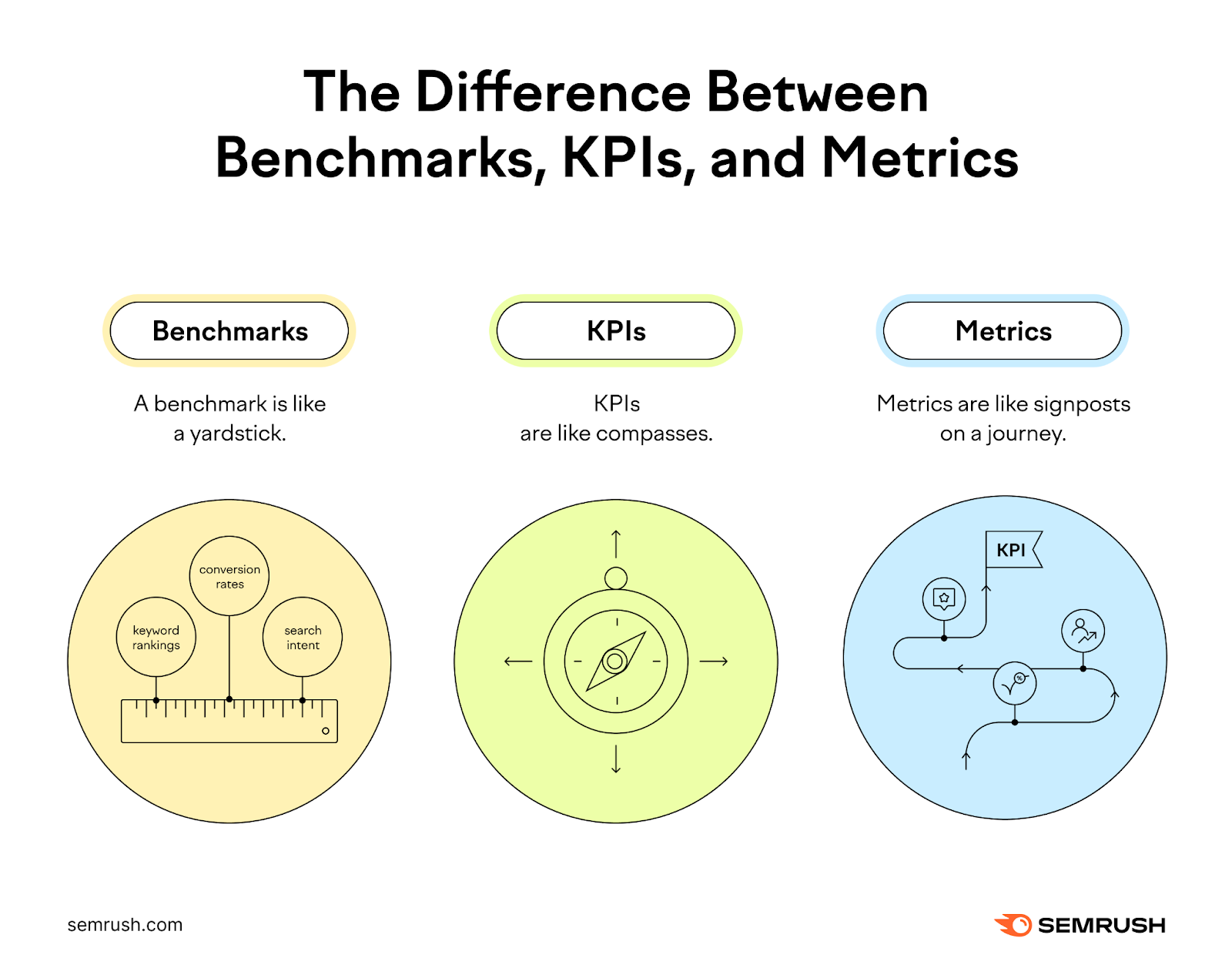
You might also want to think about the following when it comes to your SEO benchmark:
Every website and business is unique. And what works for one may not work for another.
For example, imagine you're on a cross-country road trip.
You've planned it meticulously, basing your route on guides and the average time it takes other travelers.
But you find a small town that you absolutely adore. And you decide to stay a few extra days.
According to the guides, you're off track. Behind schedule.
But does that mean your trip is a failure? Of course not! You're having a great time. And you've discovered a new place you love.
This scenario is similar to why relying only on industry SEO benchmarks can be misleading.
They're like travel guides—based on averages and may not reflect your unique journey.
That's why it's important to set your own SEO benchmarks. Customized to your unique needs and goals.
These custom benchmarks will give you a more accurate idea of how your website is performing. And reflect its individual identity in the vast digital world.
Why Is Tracking SEO Metrics Important?
Keeping an eye on SEO metrics provides valuable insights into the effectiveness of your benchmark SEO strategies.
These metrics shine a light on aspects like:
- How much organic traffic your website is attracting
- Which pages are performing the best
- Where your visitors are coming from
This information helps you benchmark SEO and fine-tune your content and design to better meet your audience's needs.
And tracking SEO metrics helps monitor your website's progress over time. You can spot trends, keep an eye on improvements, and catch potential problems before they get out of hand.
You have to stay on top of your website's SEO performance to make a mark and reach your business objectives.
In other words:
Tracking SEO metrics is like having a reliable compass and a detailed map.
You can confidently chart your course, make necessary adjustments, and see the treasures of increased traffic and higher rankings on your horizon.
10 Top Benchmarks to Establish for SEO Success
Here are the key benchmarks to focus on for your website's success:
1. Organic Traffic
Organic traffic is the number of visitors that come to your website through non-paid search engine results.
It shows the number of potential customers you are reaching organically. And can give you an idea of your website's popularity and visibility in search engines.
For example, if you're an ecommerce company, organic traffic may indicate the number of people browsing your website (and potentially making a purchase).
To establish and track organic traffic, you can use tools like Semrush’s Organic Traffic Insights.
This tool provides a detailed breakdown of your website's organic traffic. Including keywords that are driving traffic and landing pages receiving the most traffic.
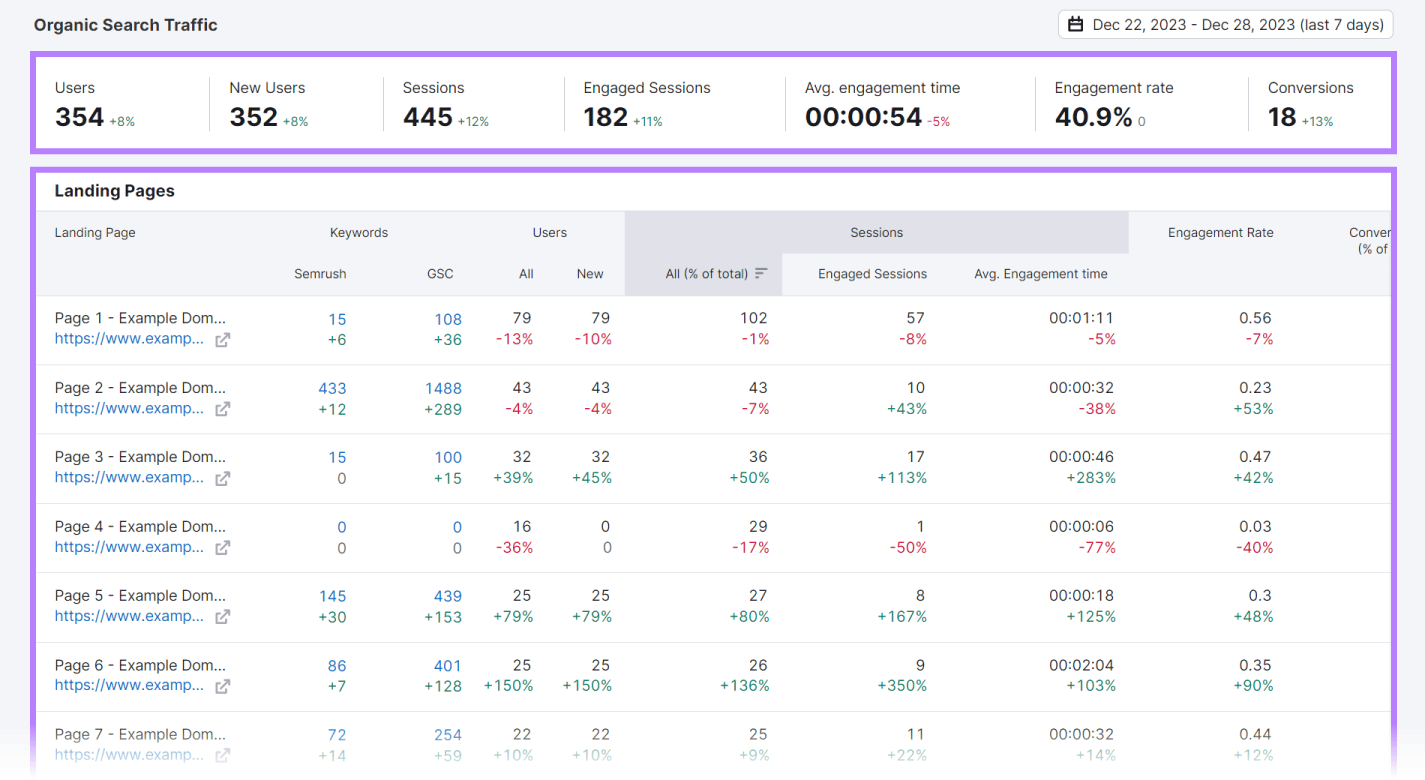
You can also use the Market Explorer tool to benchmark your organic traffic against that of your competitors in the market. It's a great way to see how you're doing compared to others in your industry.
To do that, go to the tool, select "Create List," choose your "Location," and enter at least three competitors’ domains. Then, click "Create and analyze.”
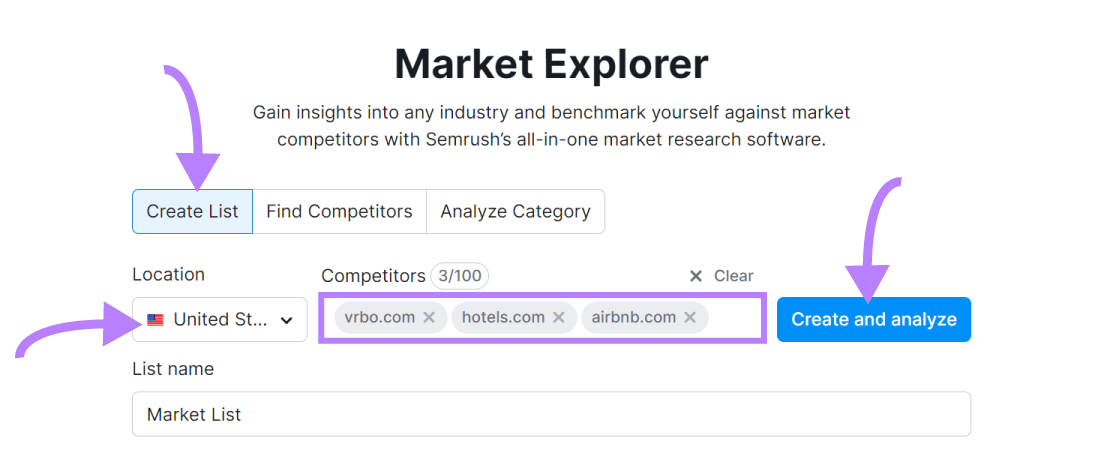
Click “Benchmarking,” and you'll see a graph comparing the organic traffic trends for all the websites.
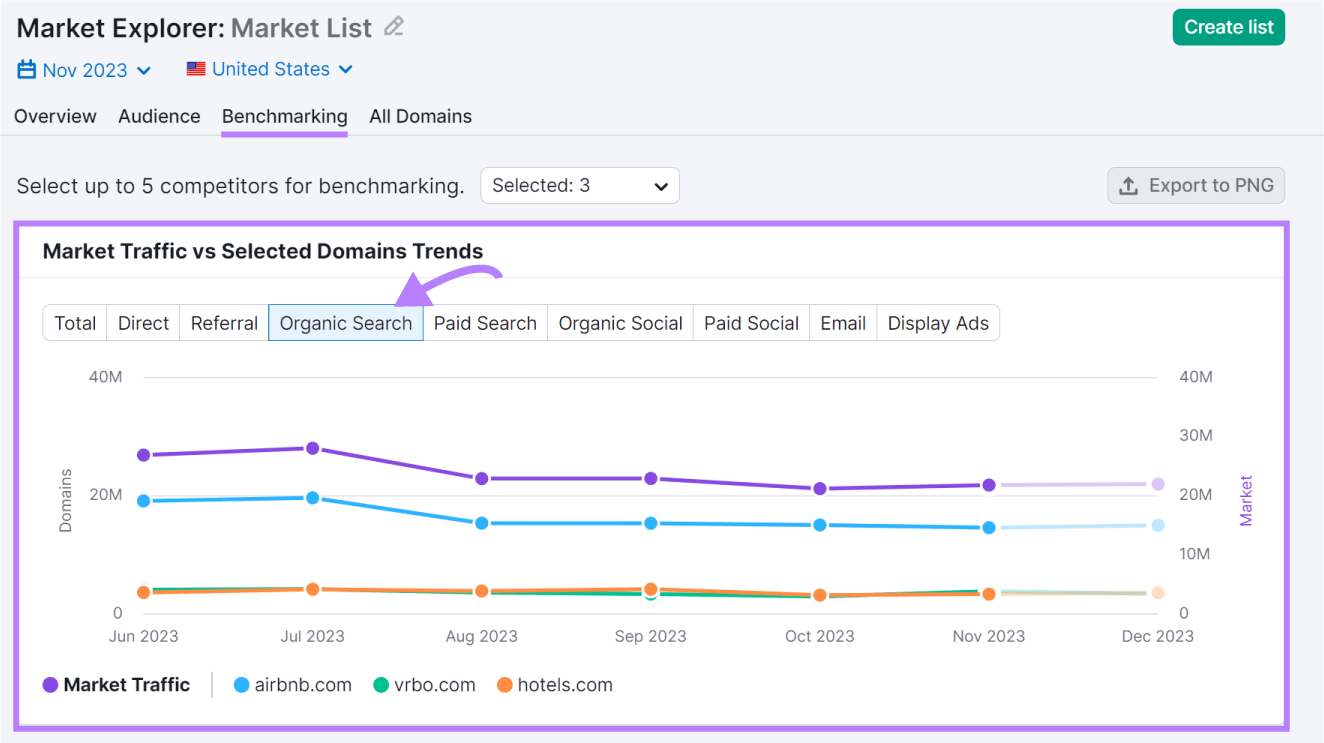
Head back to “Overview” and can also see the top organic keywords for each website and their traffic share.
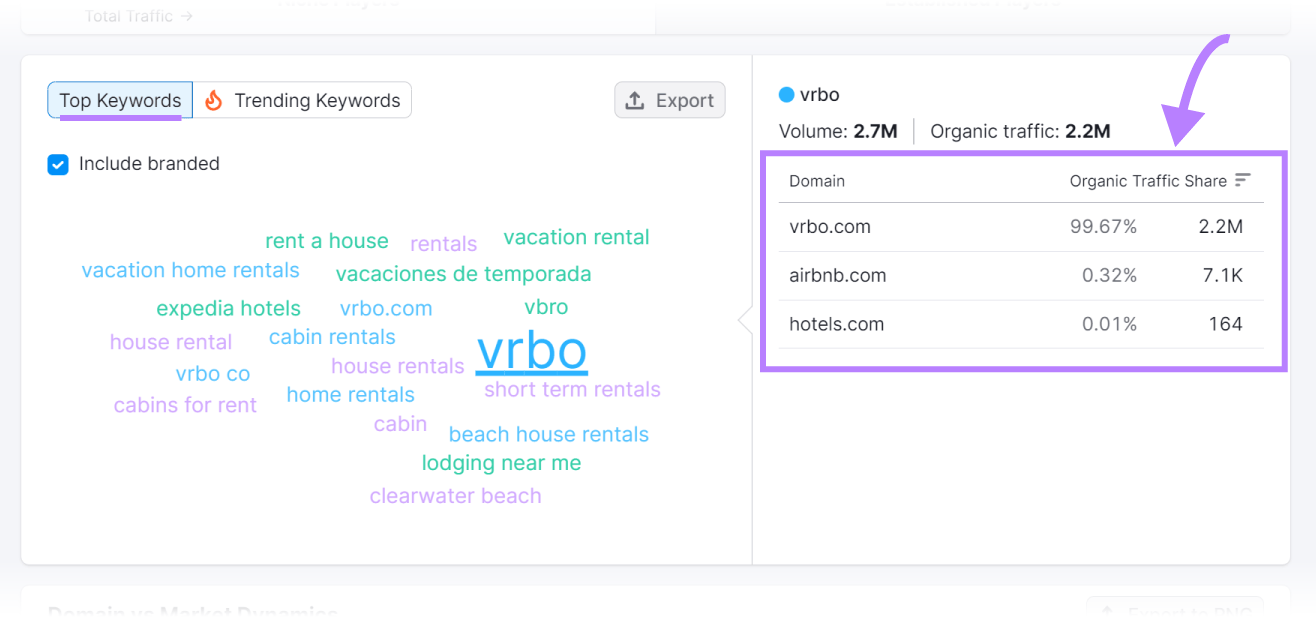
Having this information will help you benchmark your SEO and identify actionable steps to improve your performance.
2. Keyword Rankings
Keyword rankings show where your website ranks in search engine results pages (SERPs) for specific keywords.
For example, if you're a bakery in New York City, you'd want your website to rank highly for keywords like "best bakery in NYC" or "pastries NYC."
Tracking keyword rankings is crucial to benchmark your SEO because:
- It gives you an idea of how well your website is optimized for certain keywords
- It lets you know which keywords to focus on and improve
- It shows you how well your SEO efforts are paying off
Put simply, the higher your website ranks for relevant keywords, the more likely people will click through and visit your site.
So, how can you track them?
You can easily track your website's keyword rankings with the Position Tracking tool.
Start by logging into your Semrush account. Navigate to the tool, enter your domain, and click on "Set up tracking."
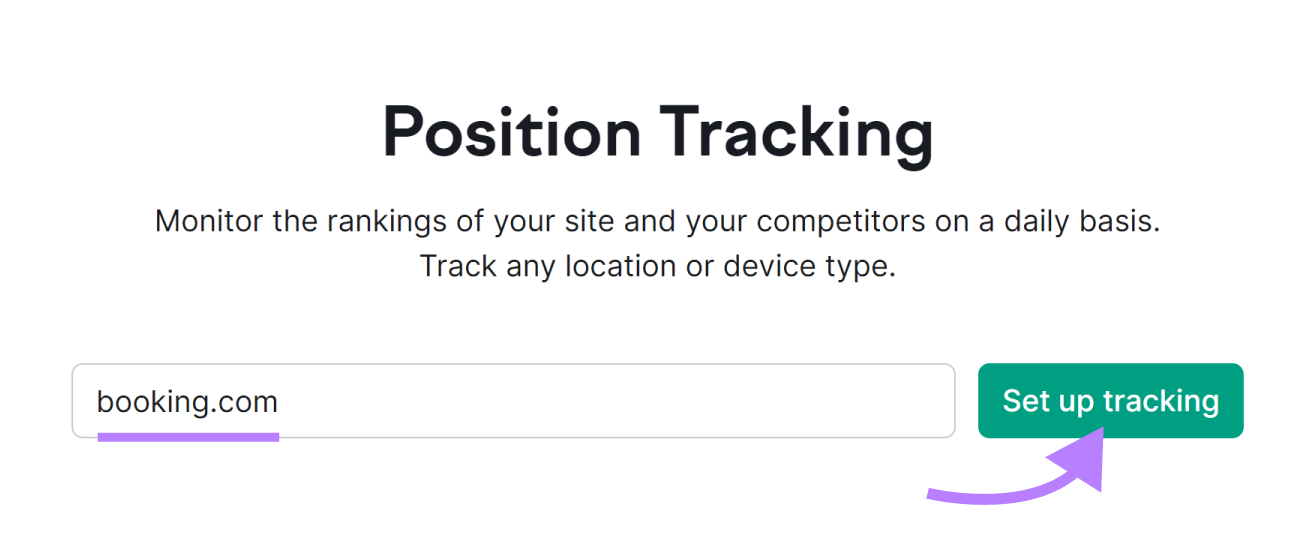
Then, configure your campaign.
Enter your location, device, and language preferences. These settings define the context for your keyword tracking.
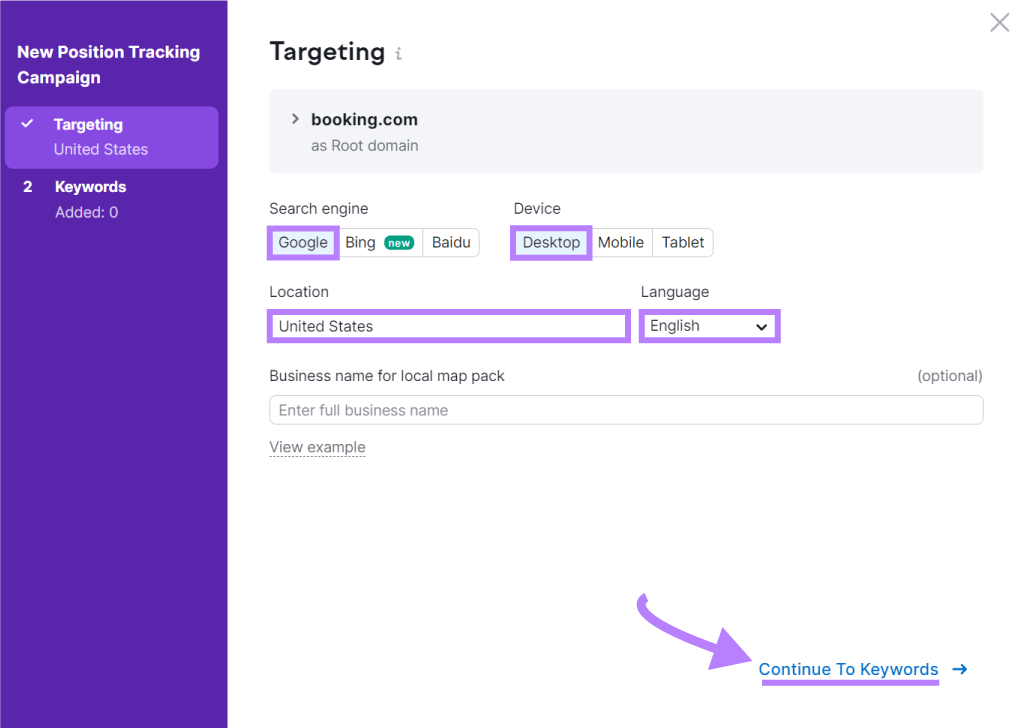
In the next step, add the list of keywords that you want to track.
You can manually enter these keywords or import them from a file, Google Analytics 4 (GA4), or Semrush's Organic Positions report. When you’re done, click “Add keywords to campaign.”
Last, click on the "Start Tracking" button. Semrush will now begin to monitor your keyword rankings based on the settings you provided.
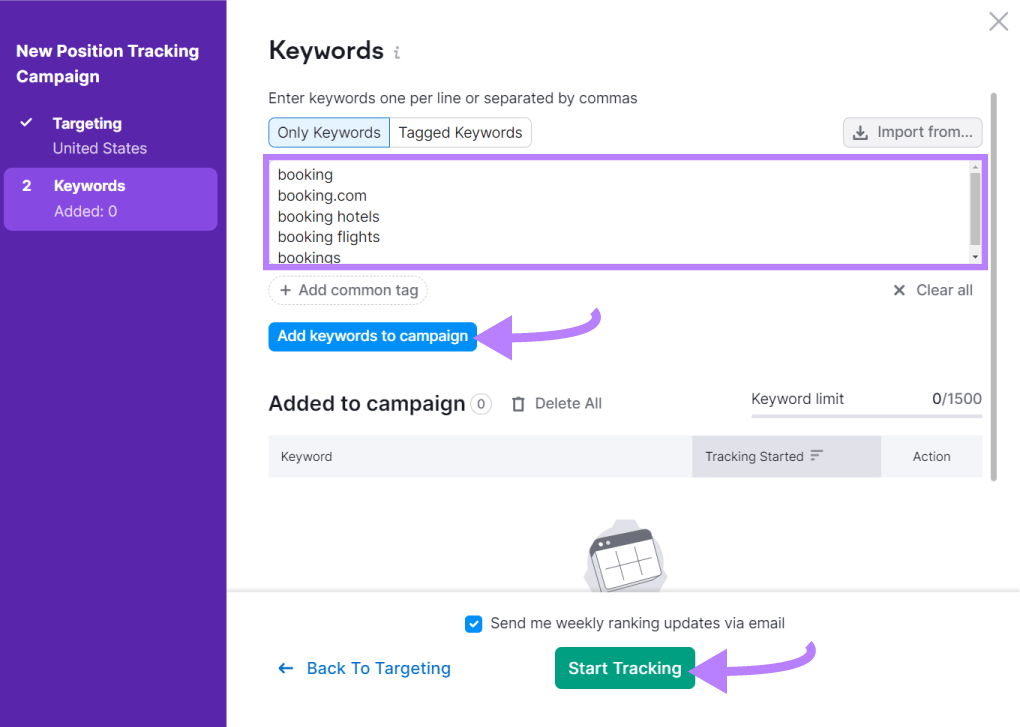
You can now check out the "Landscape" tab of your project anytime to keep an eye on your SEO progress.
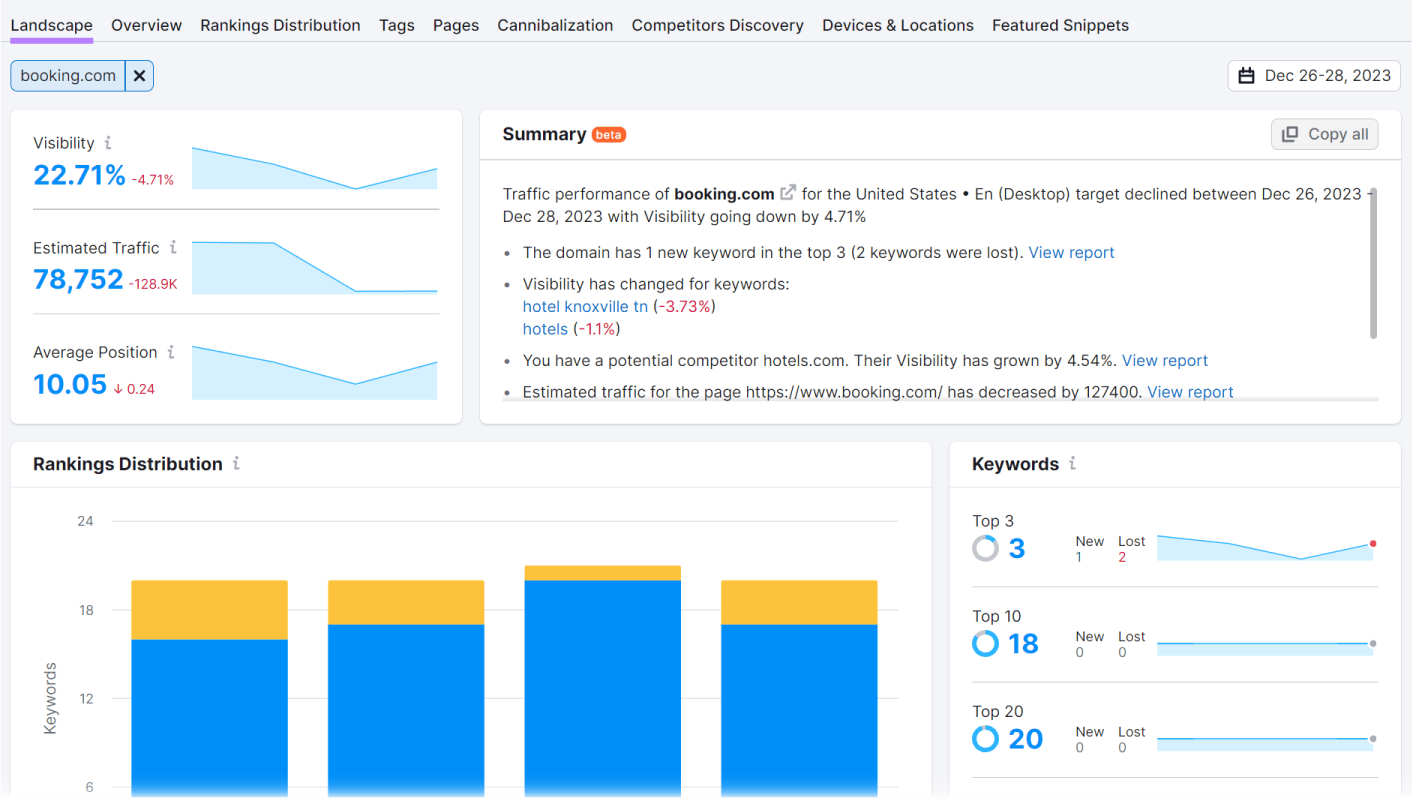
This tool gives you valuable insights like visibility, estimated traffic, and average position for your keywords. Plus, you can track changes in your keyword rankings over time.
You can also use Semrush’s Keyword Gap tool to benchmark your website's ranking for specific keywords against those of your competitors.
Just enter your domain and up to four competitors' domains. And the tool will show your website's keywords, your competitors' keywords, and any overlaps.
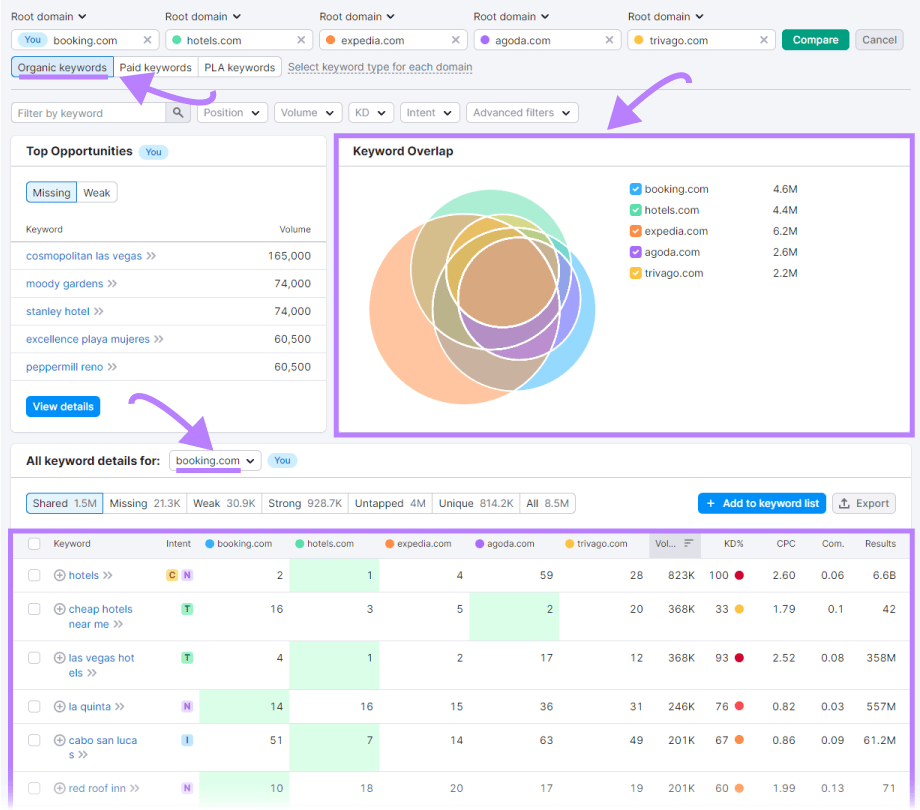
Having this information can help you identify new keyword opportunities to improve your rankings. It also reveals areas where you need to focus more effort to close the gaps with your competitors in terms of benchmark SEO.
3. Impressions and Clicks
Impressions are the number of times your webpages have shown up in SERPs.
And clicks show the number of times users have clicked on your website's link from those impressions.
So, why are these metrics important?
Because they show how well your website or its pages are attracting clicks from impressions.
For example, if your website appears in a search for "best pizza in Chicago," and 100 people see it (impressions), and five click on it (clicks), then your click-through rate (CTR) would be 5%.
In other words:
A high impression count with low clicks indicates an opportunity to improve your title tags and meta descriptions for those pages.
To track impressions and clicks, you can use Google Search Console (GSC).
Click on “Search results” under the “Performance” tab. You'll see a graph showing your website's total impressions and clicks over time.
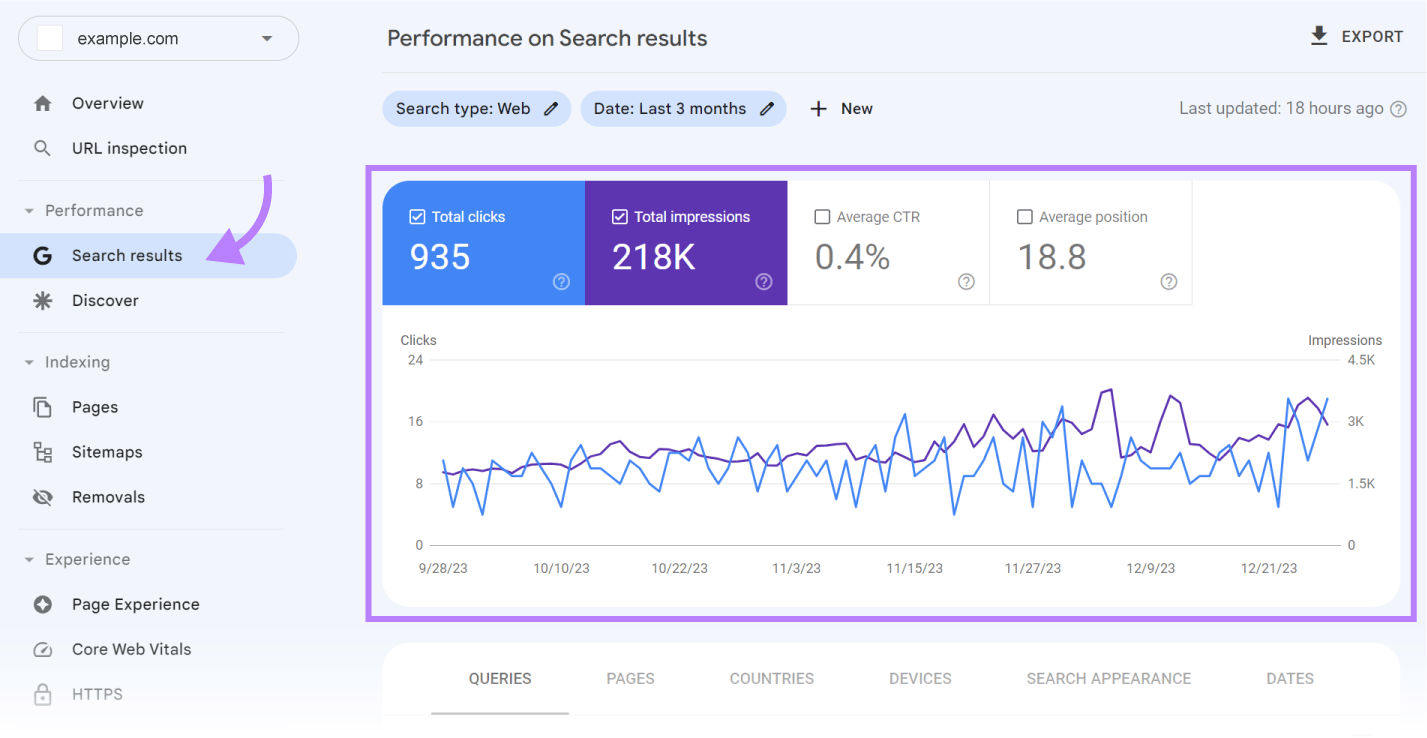
And if you want to benchmark your performance against competitors, you can use the "Competitors Discovery" tab in the Semrush Position Tracking tool.
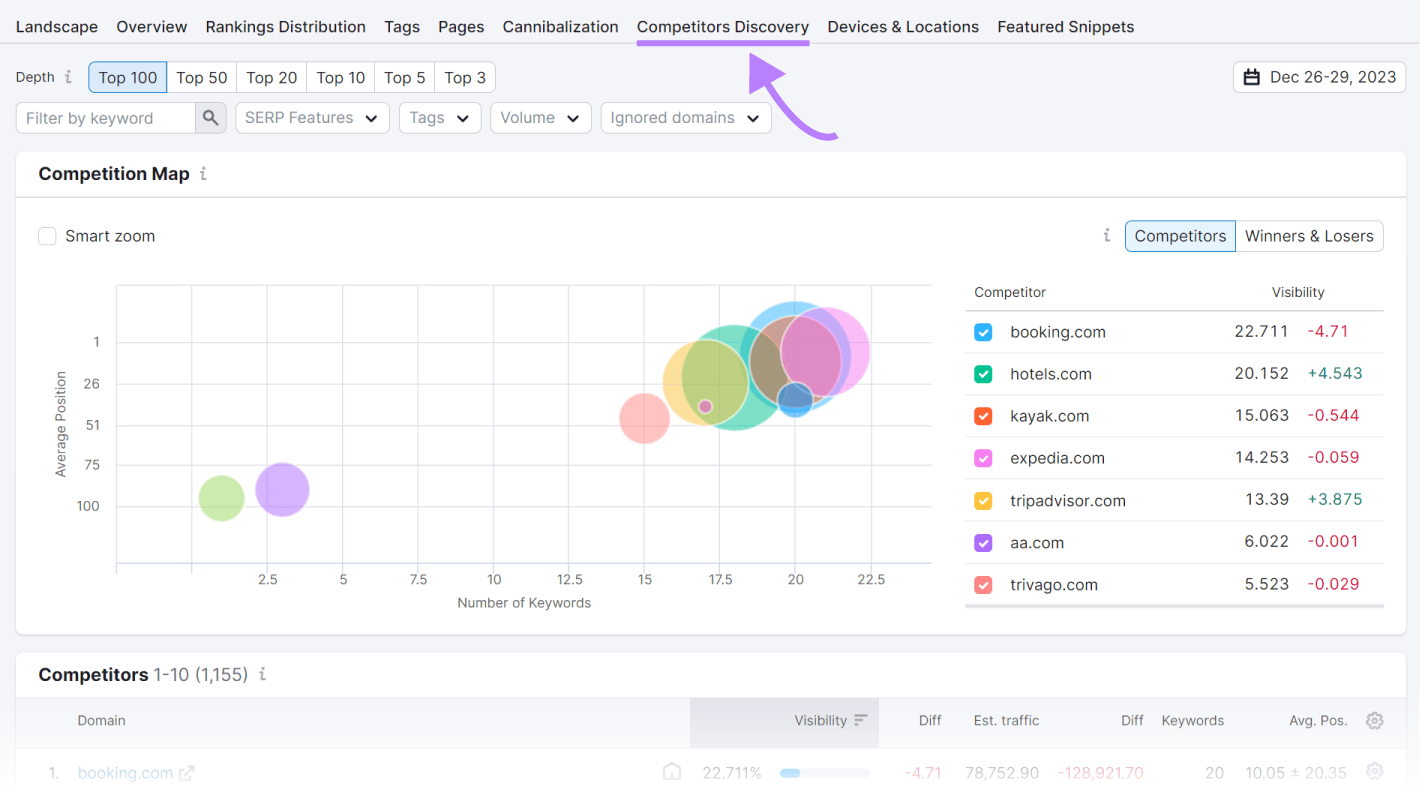
Here, you'll find a list of your potential competitors based on the keywords you're tracking. Semrush determines these competitors based on their visibility for the same set of keywords.
You can sort the list by visibility, estimated traffic, or common keywords.
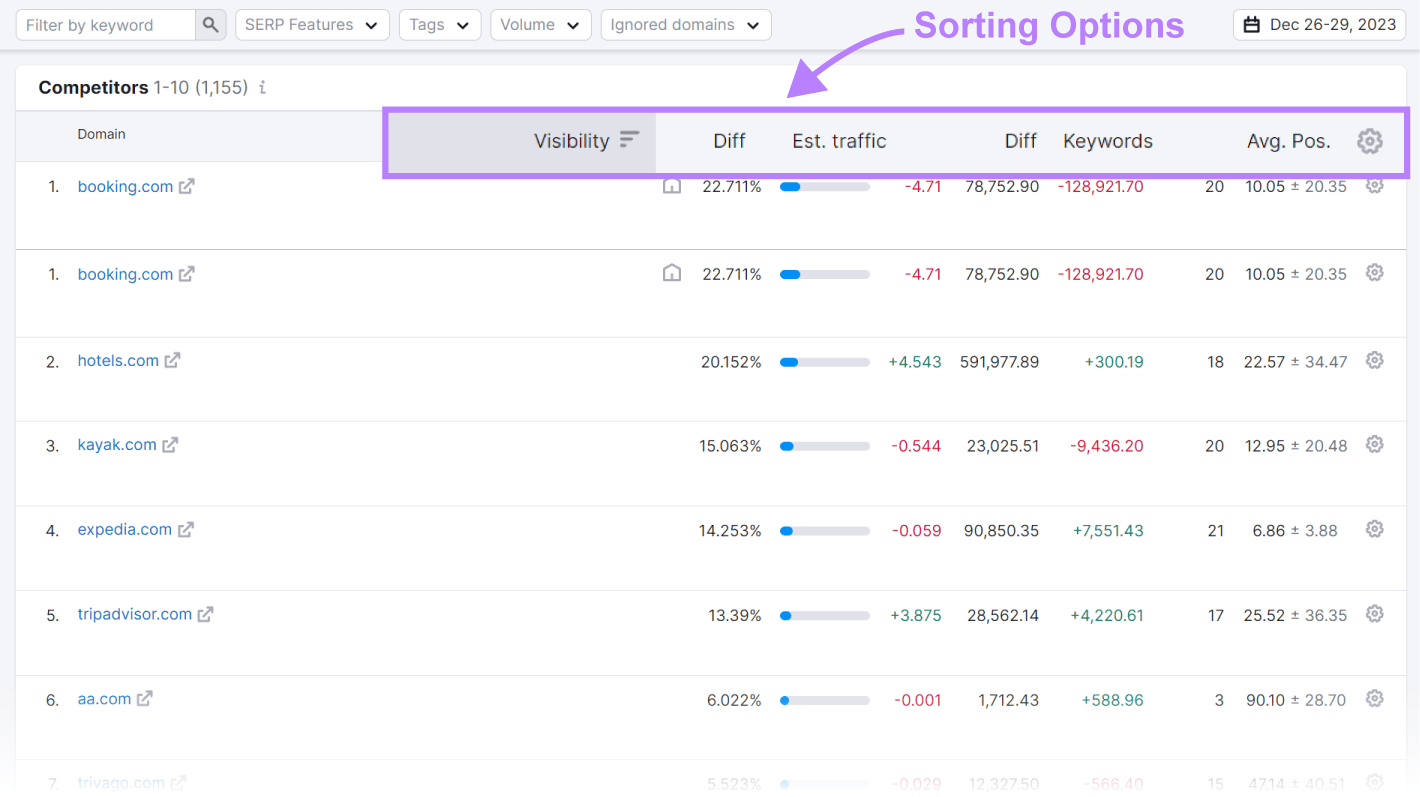
To get more insights into a specific competitor, simply click on their domain. You'll see a detailed side-by-side comparison of your and your competitor’s keywords.
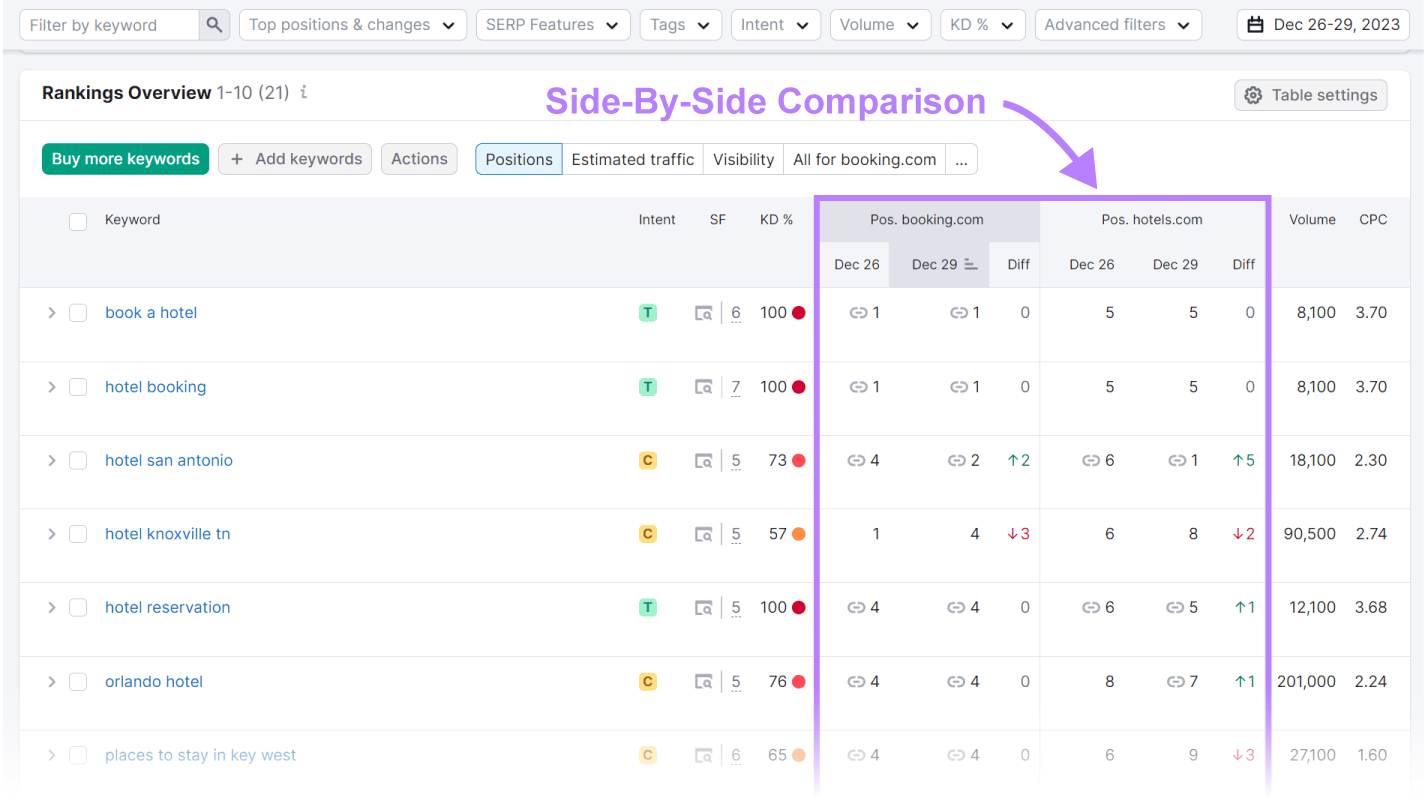
By default, Semrush displays data for all keywords. Use the filter options to segment data by keyword type, search volume, or any other parameter you're interested in.
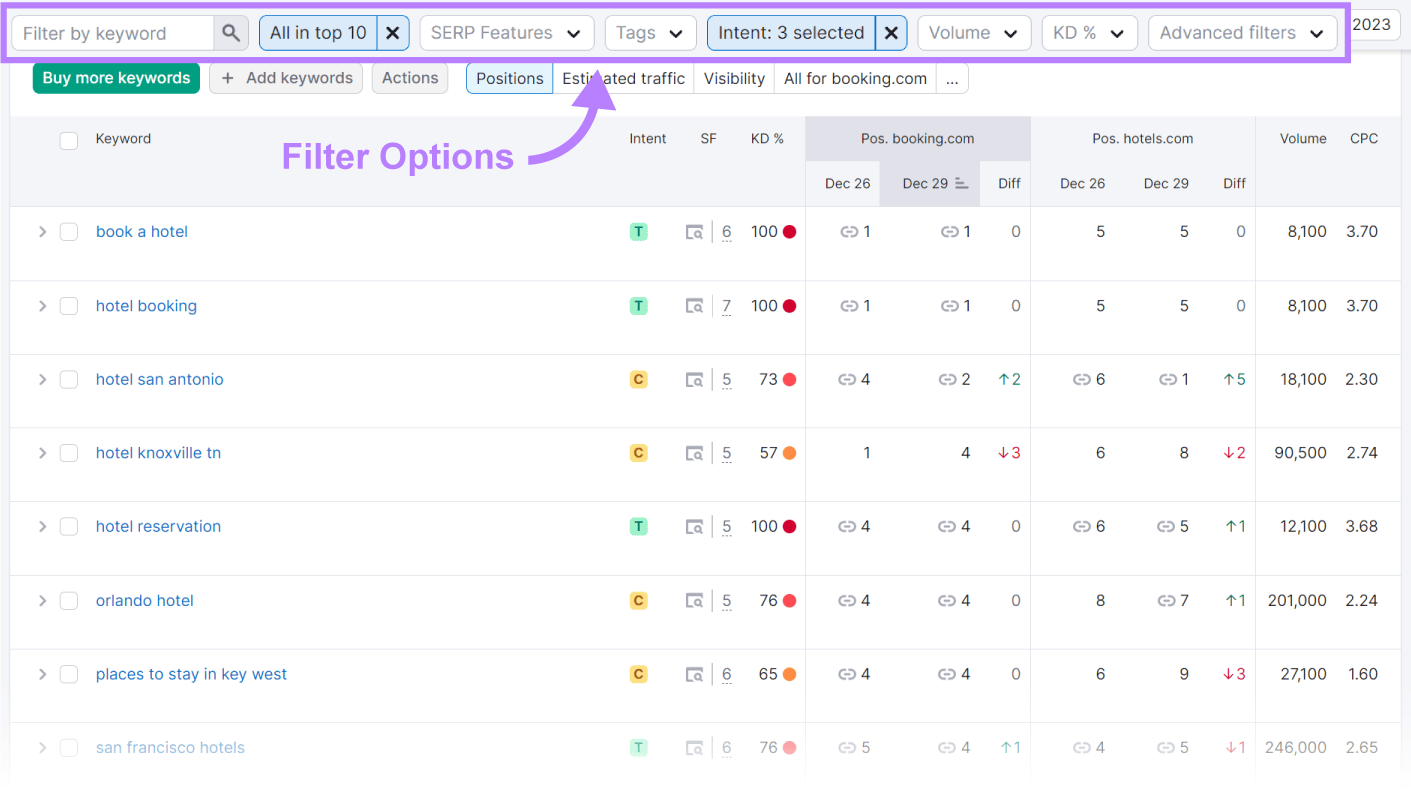
Having this information can help you benchmark your website's SEO performance against others in search results. It also provides insights into areas that require improvement to enhance visibility and drive more clicks.
4. Bounce Rate
Bounce rate measures the percentage of visitors who leave your website after viewing only one page.
For example, if a visitor lands on your homepage and doesn't click on any other page before leaving, that counts as a bounce.
It's an important metric to track because it shows how engaging and relevant your website's content is to visitors. And this means it can help you identify areas for improvement.
To establish or track your website's bounce rate, you can use Google Analytics 4 (GA4) or Semrush's Traffic Analytics tool.
Google Analytics is free and provides a detailed breakdown of your website's bounce rate. Including specific pages and traffic sources.
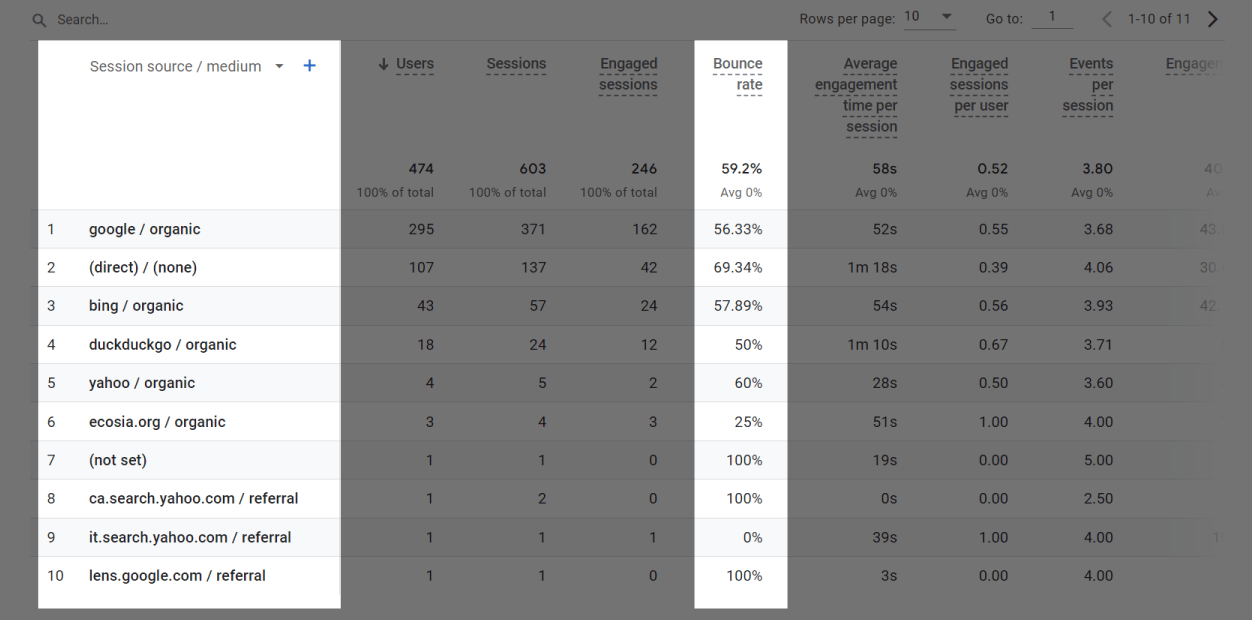
If you want to compare your website's bounce rate against competitors, you can use the Traffic Analytics tool.
Just enter your domain and up to four competitors' domains, then click “Analyze.”
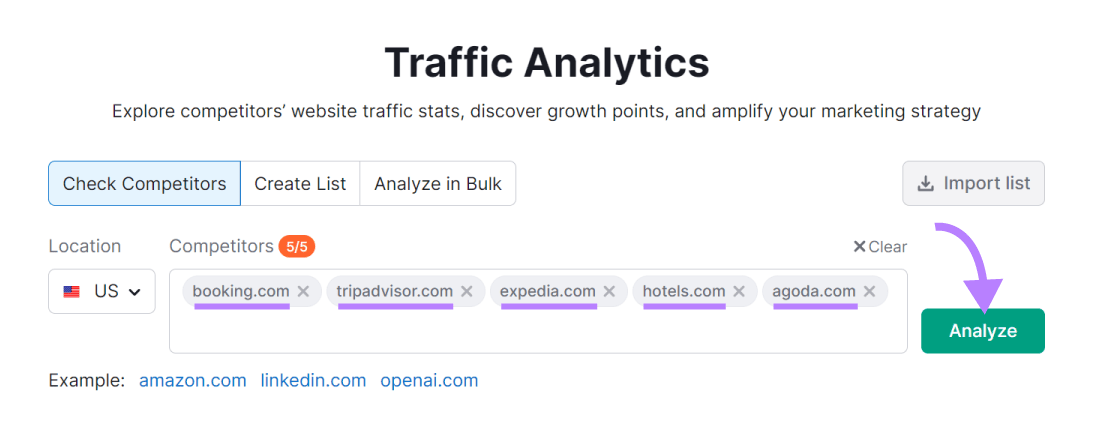
The tool will show you a side-by-side comparison of bounce rates for each website.
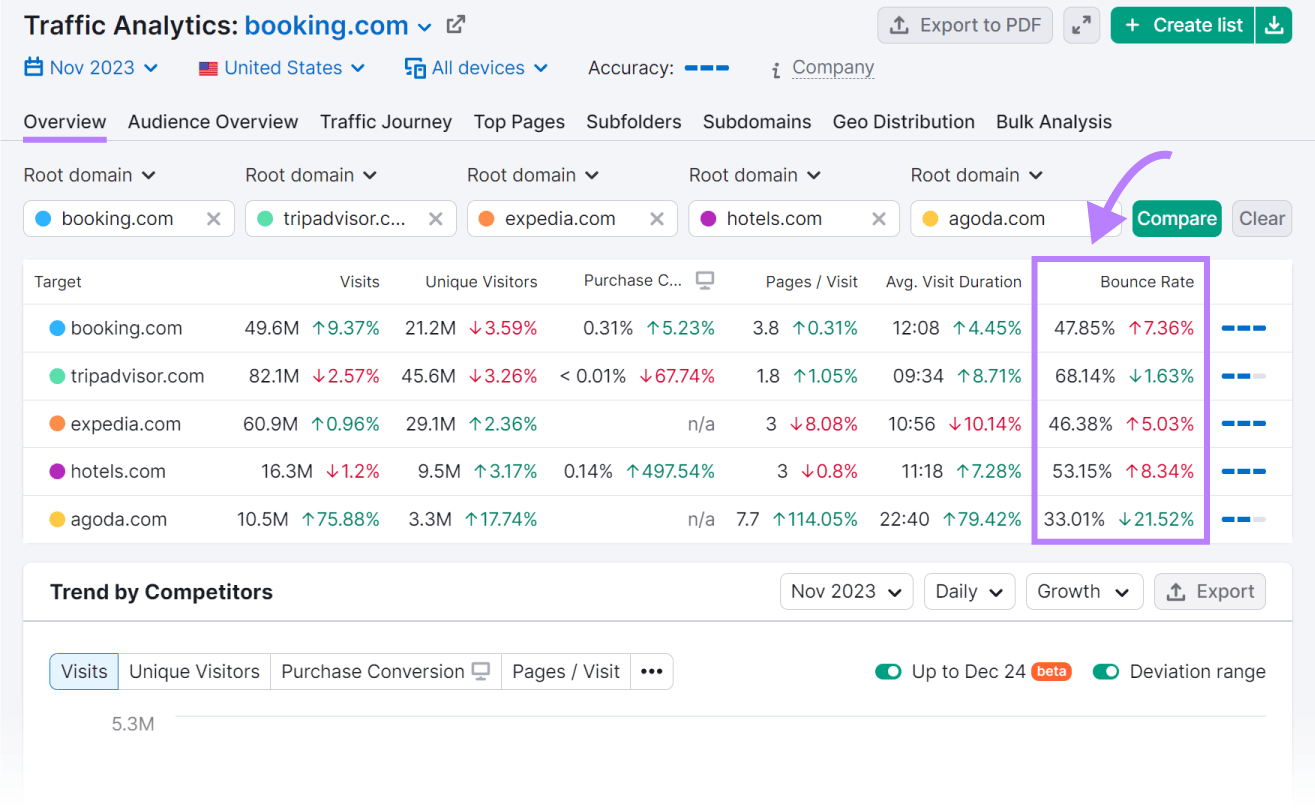
Benchmarking your bounce rate against competitors can give you valuable insights into industry standards and where you stand.
5. Returning Visitors
Returning visitors are users who have visited your website before and have returned for another visit. It shows the loyalty of your audience and how effective your website is in retaining them.
Or, to put it another way:
If your website has a high number of returning visitors, it could mean that your content is valuable and engaging enough to keep people coming back for more.
(This isn’t strictly about SEO. But it can tell you something about the value of your content and your ability to transform SEO traffic into a long-term audience.)
How do you track returning visitors?
You can use Google Analytics 4 or Semrush's Traffic Analytics tool.
In Google Analytics 4, you just have to go to the "Reports" section and click on "Retention." There, you'll find an SEO benchmark report showing new vs. returning users.
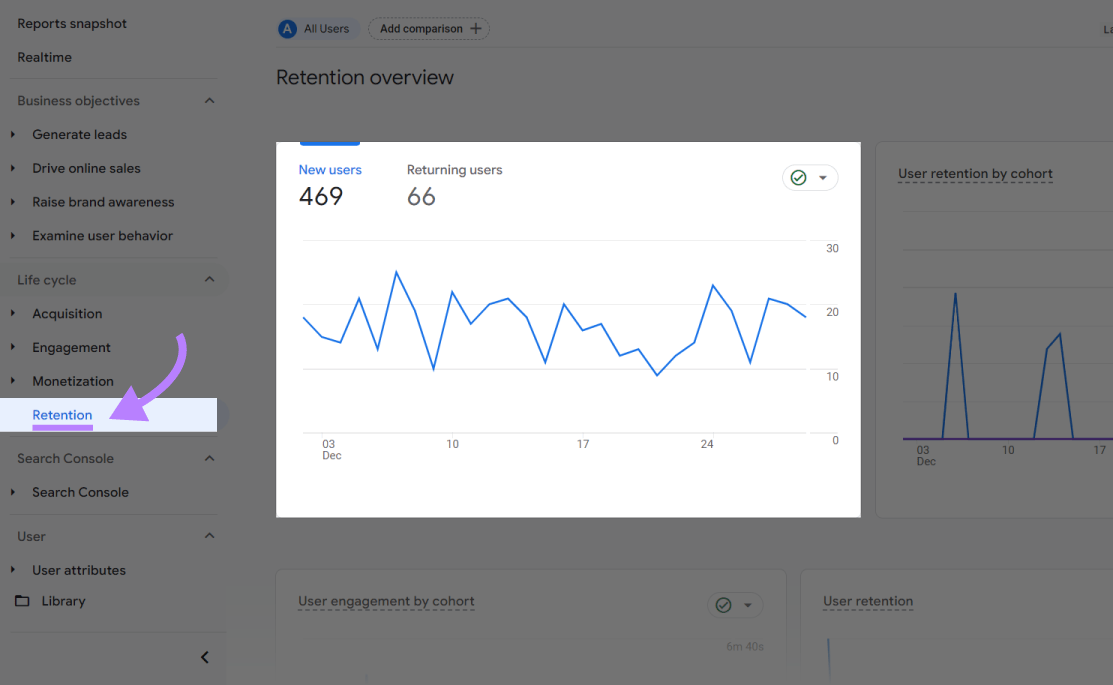
And if you want to compare your website's returning visitor rate against competitors, you can also use the Traffic Analytics tool.
Let's assume you've already entered your domain and your competitors' domains before. And the tool showed you a side-by-side comparison of returning visitors.
There, just go to the "Trend by Competitors" and select "Visits."
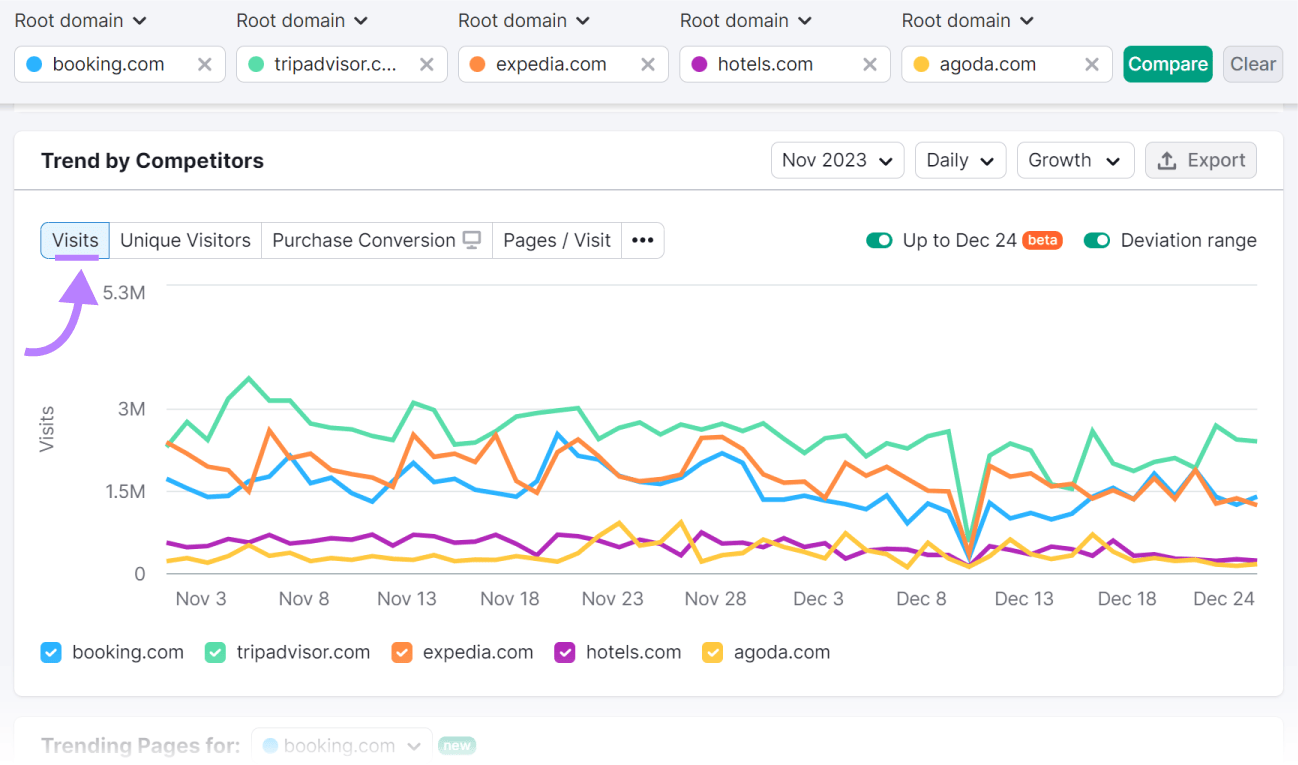
6. Average Engagement Time
The average engagement time measures the amount of time visitors spend on your website.
It reflects how engaged and interested they are in your content. And it also shows how effective your website is in keeping users on your site.
For example, if your website has an average engagement time of five minutes, it could indicate that users are finding valuable information. And spending a significant amount of time consuming it.
You can track the average engagement time using the Organic Traffic Insights tool.
It contains data from Google Analytics and Semrush's own algorithms to give you a comprehensive view of your website's performance.
Just go to the tool and scroll down to find the average engagement time.
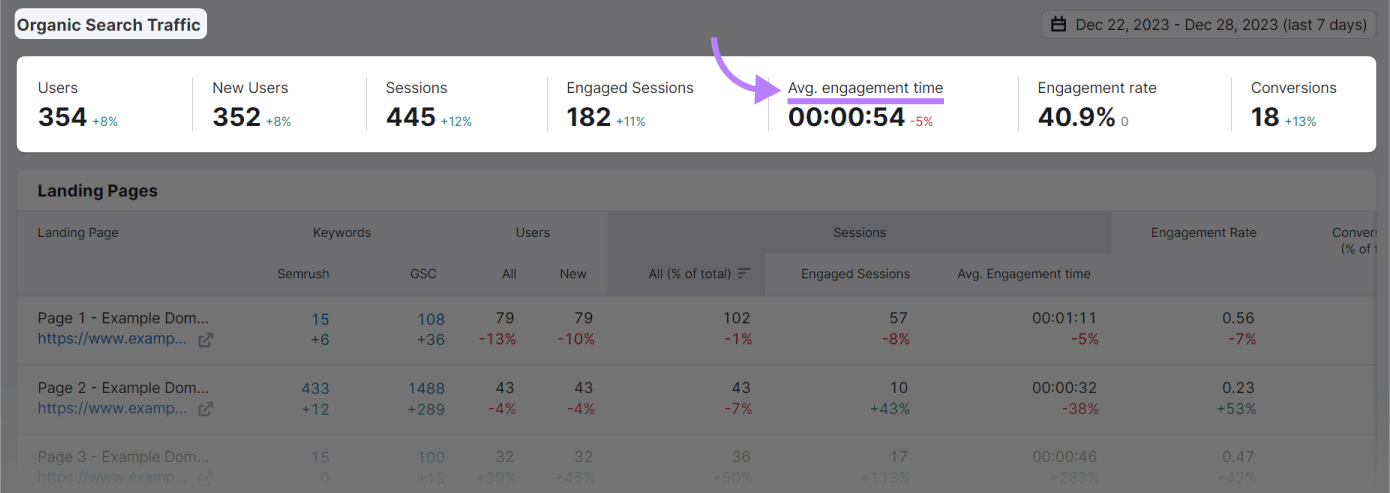
And you can also use Semrush’s Traffic Analytics tool if you want to benchmark your average engagement time against competitors.
Just head over to the tool, pop in your domain and your competitors' domains, and hit "Analyze."
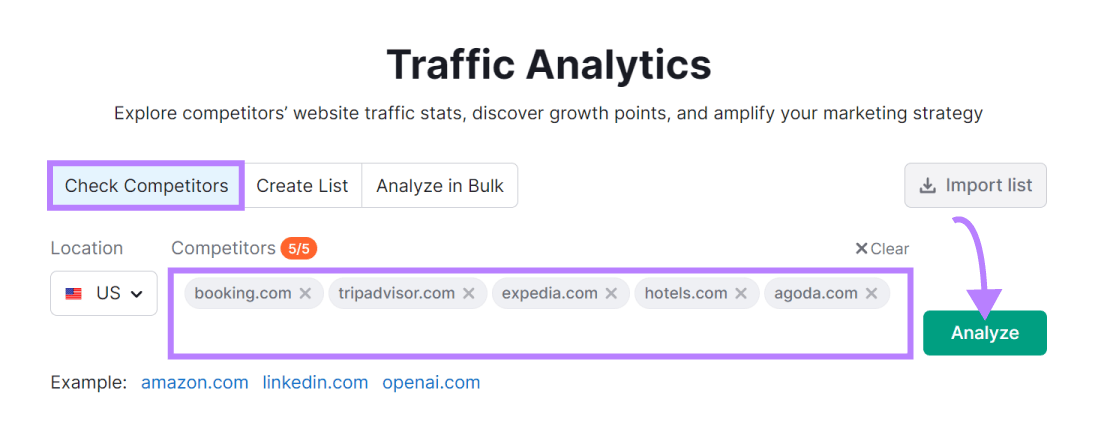
And you'll get a side-by-side comparison of how long people are sticking around on each website.
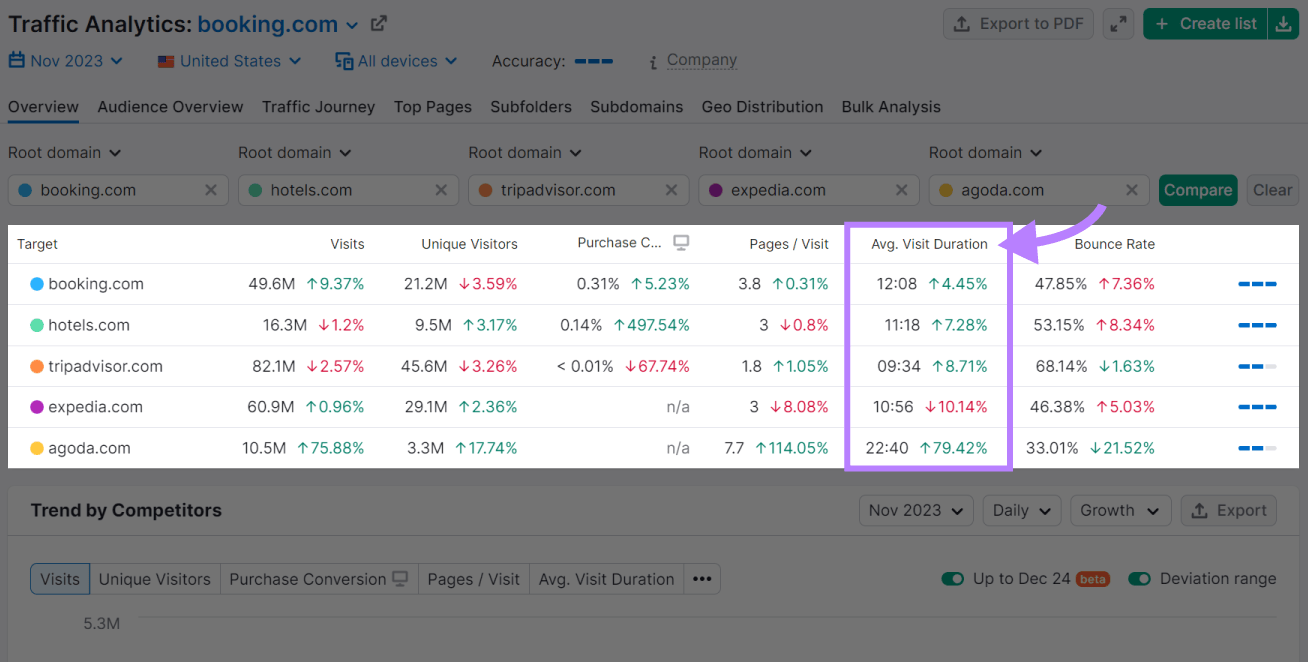
7. Conversion Rate
The conversion rate is the percentage of visitors who complete a desired action on your website. This could mean buying something, filling out a form, signing up for a newsletter, or whatever else you're aiming for.
For example, if 100 visitors come to your website and five of them make a purchase, then your conversion rate is 5%.
It shows how well your website turns visitors into customers or leads. A low conversion rate could mean there are some problems with your website's design, user experience, or targeting.
You can track a conversion with Google Analytics 4. You just have to create or find an event that measures the important user interaction. Then, mark the event as a conversion.
So, let's say you're using Google Tag Manager (GTM).
You'd create the event for your website.
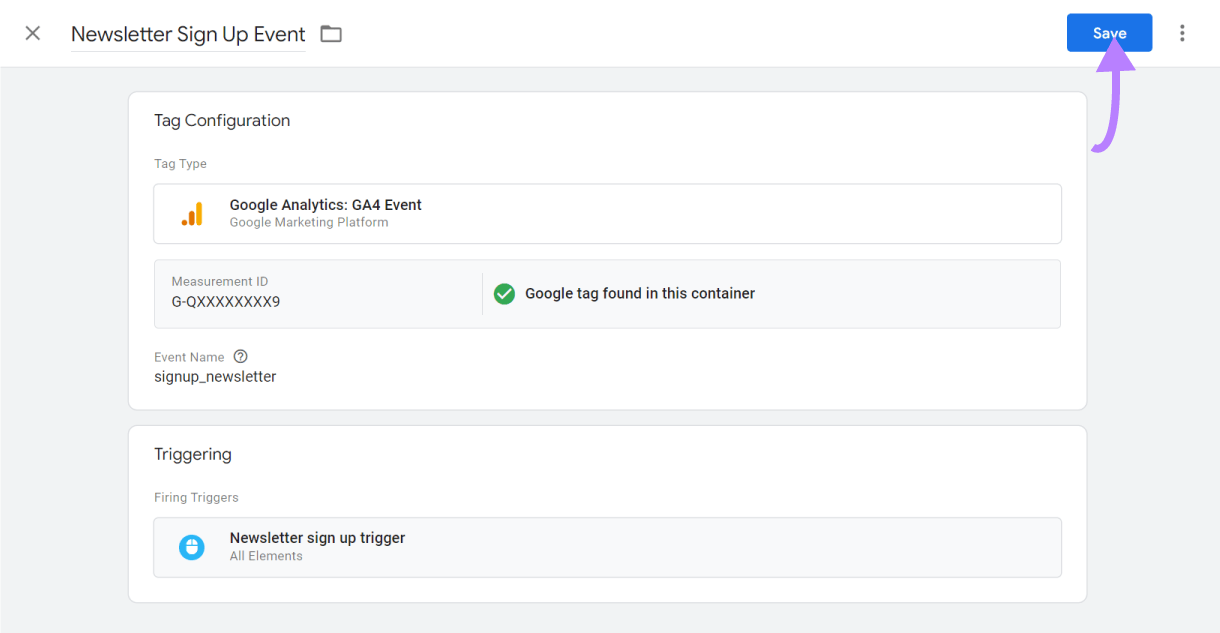
Then, head over to Google Analytics to mark it as a conversion.
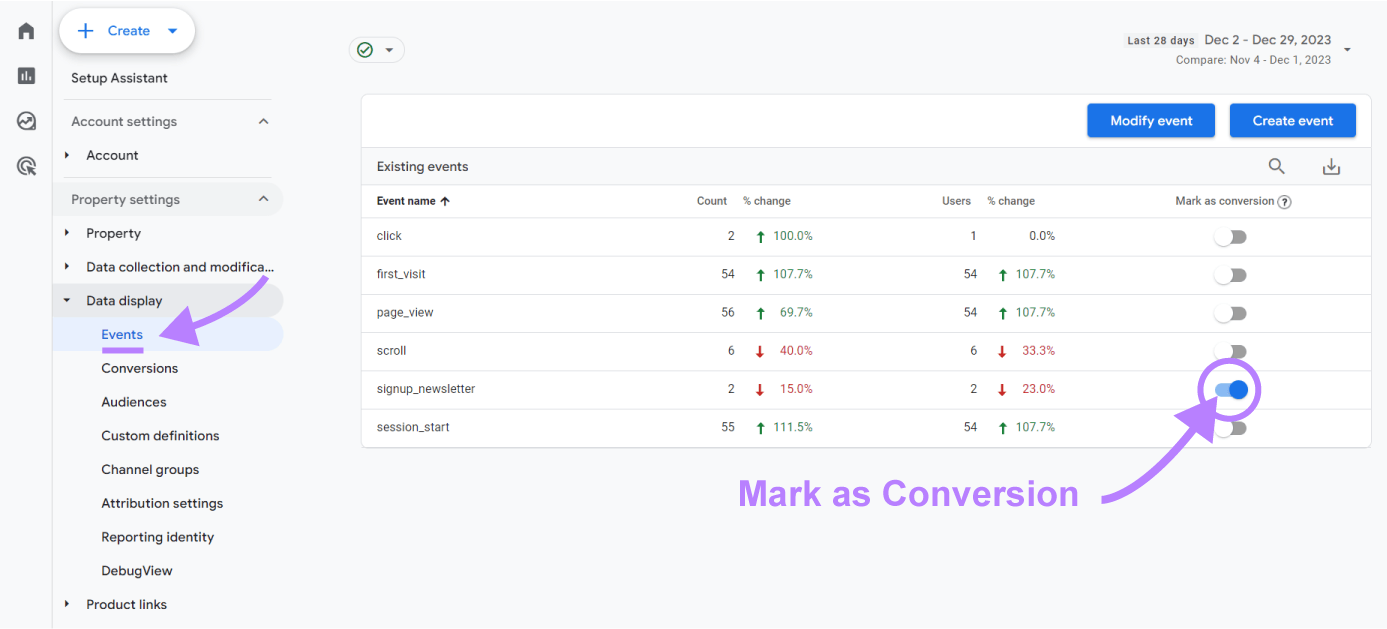
8. Referring Domains
Referring domains are other websites that link to your website.
For example, if you're a travel blogger and the travel website Culture Trip links to your article, they’re a referring domain for you.
The link is called a backlink; the site linking to you is called a referring domain. One site can give you multiple backlinks, but it can only give you one referring domain.
But why should you care about referring domains?
In the eyes of search engines like Google, they act as endorsements from other sources. This can improve your website's rankings, traffic, and authority.
Here’s how to see your referring domains:
Semrush's Backlink Analytics tool. It allows you to see all the websites linking to your domain. And analyze their quality and relevance.
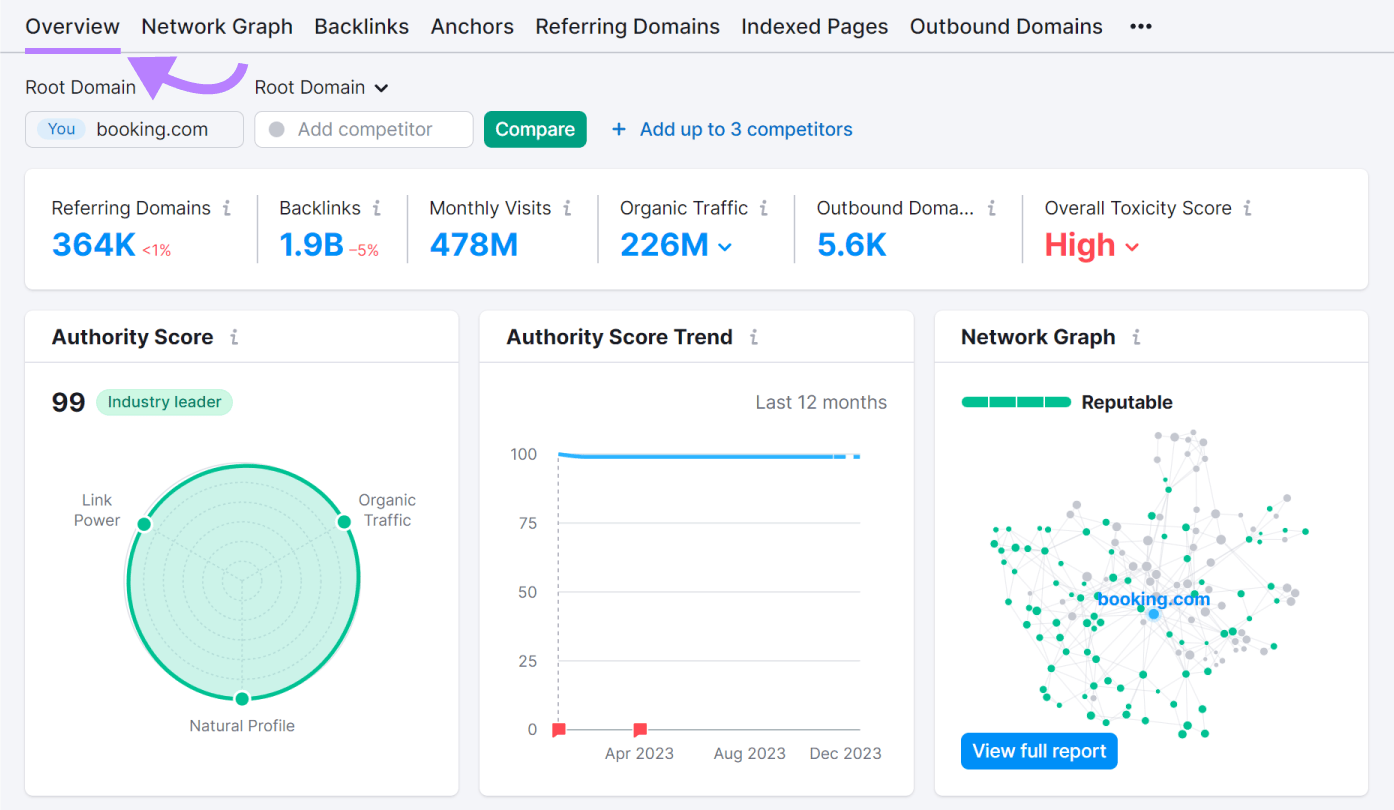
And if you want to compare your backlinks against competitors (and get their successful ones), you can use the Backlink Gap tool.
Simply enter your domain and your competitors' domains. The tool will then show you the overlapping and unique backlinks between them.

This way, you can identify potential opportunities and gaps in your backlink profile. And work toward improving your website's authority and credibility.
9. Domain Authority Score
Domain Authority Score is a Semrush metric used to assess the overall “strength” or authority of a website's domain.
It's calculated based on various factors. Such as the number and quality of backlinks, content relevance, and overall website performance.
Tracking your domain Authority Score can give you an idea of how well your website is performing in terms of credibility and trustworthiness.
A higher Authority Score can also mean better search engine rankings, as search engines tend to favor websites with a strong and authoritative online presence.
However, search engines do not recognize or measure Authority Score or any other proprietary metric created by third-party companies.
To track your Authority Score, you can use Semrush's Domain Overview tool. This tool allows you to enter your domain and see its overall performance, including the Authority Score.
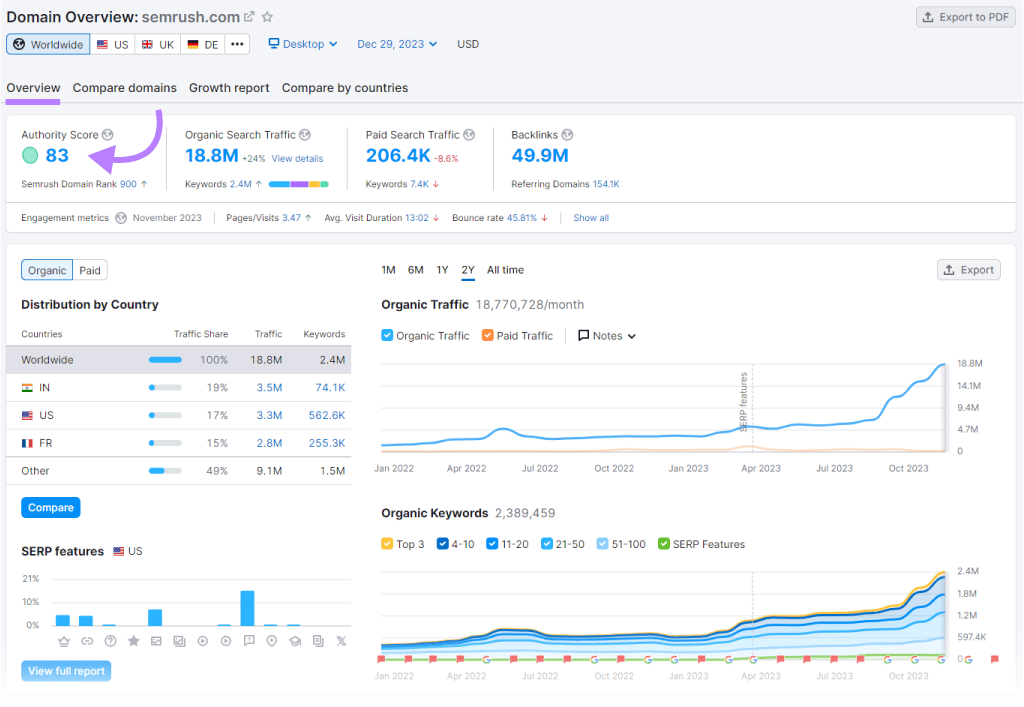
You can also compare your authority against your competitors' using the "Compare domains" feature.
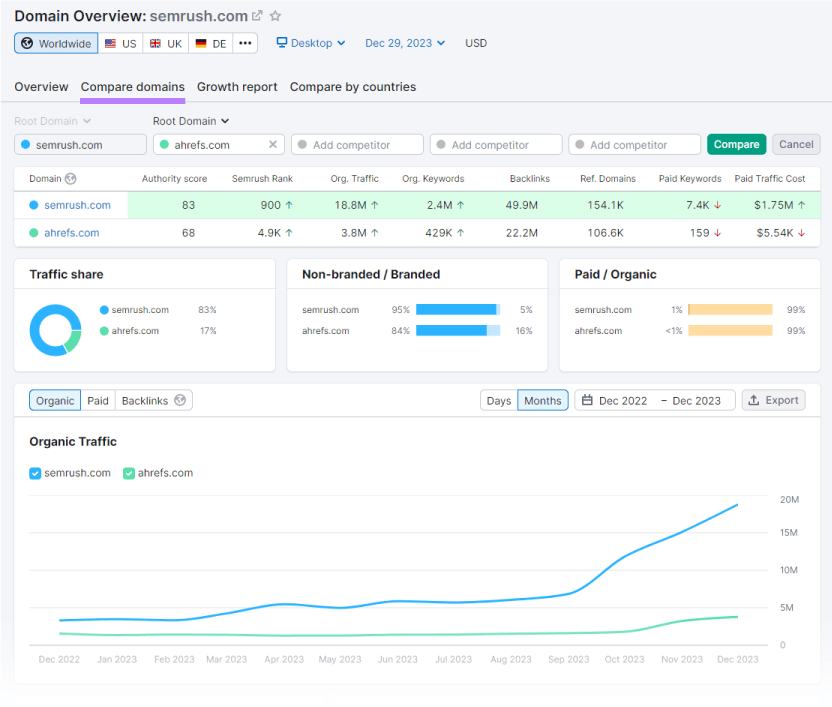
This will give you a better understanding of where you stand in relation to your competitors. And how you can improve your website's overall authority.
10. Share of Voice
Share of voice measures the percentage of visibility or exposure your website has in comparison to your competitors in the online space. This includes both paid and organic search channels.
Tracking your share of voice is important because it gives you an understanding of how well you are competing against other websites in your industry. It also allows you to identify any gaps or opportunities for improvement.
To establish and track your share of voice, you can use Semrush's Position Tracking tool.
This tool allows you to enter your domain and your competitors' domains to track your search visibility in comparison.
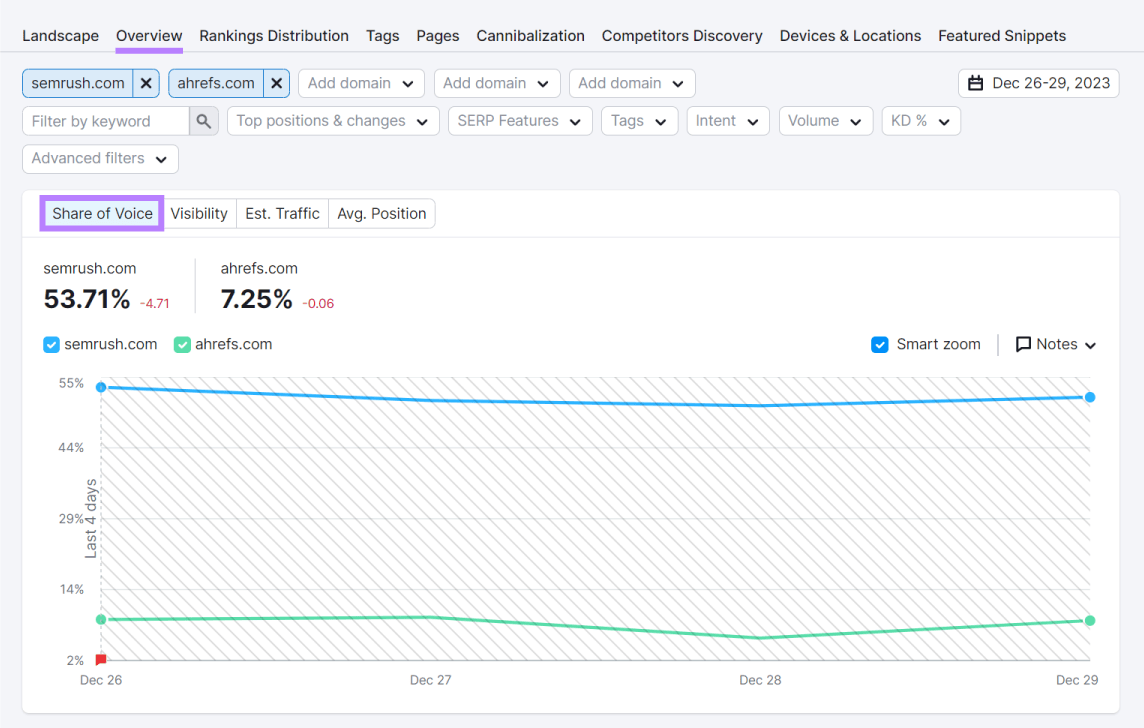
Tracking your share of voice can give you valuable insights into how to stay ahead of the competition and increase your online visibility.
What Next?
Now that you've got your SEO benchmarks in place, it's time to roll up your sleeves and get down to business.
Let's recap how some of our tools can help you:
- Organic Traffic Insights: Analyzes your website's organic traffic, including top keywords and landing pages
- Position Tracking tool: Tracks your website's ranking positions for target keywords. And lets you compare them with competitors.
- Traffic Analytics tool: Provides insights into website traffic. Including unique visitors, engagement metrics, and traffic sources.
- Backlink Analytics tool: Analyzes the backlinks pointing to your domain and their quality
- Backlink Gap tool: Shows the overlapping and unique backlinks between you and your competitors
SEO is an ongoing journey, so make sure to keep a close eye on your metrics.
Adapt your digital marketing strategies based on results and aim to surpass goals. Stay ahead by anticipating SEO trends and adjusting accordingly.
What should be next on your list?
You can dive deeper into keyword research or optimize your site structure for better crawlability.
To kick things off, we've got a deal for you—a free Semrush account.
